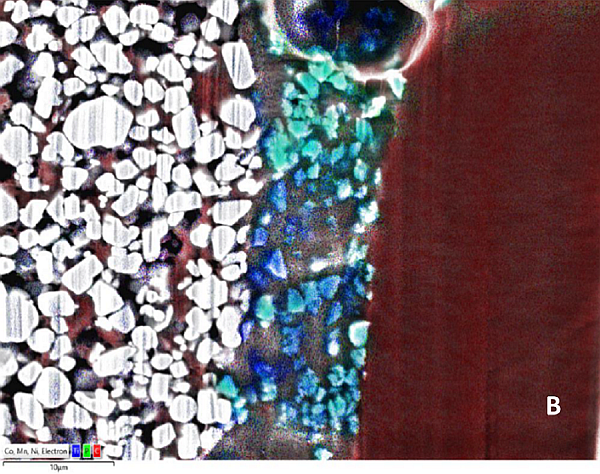March 2023
Intermediate result from partner: RWTH, cells provided by CIDETEC.
Post-mortem analysis is a collection of methods, which are used to investigate a battery usually after it has reached its end of life. It involves opening the cell under a protective argon atmosphere and characterizing the different parts optically, chemically and electrically. Because of the uniqueness of solid-state batteries, established post-mortem protocols have to be adapted.
- Objective: The aim of the post-mortem analysis is to find the main aging mechanisms of solid-state batteries. Furthermore, the effect of different operating conditions on the aging rate is investigated to support the development of a lifetime model. Aging mechanisms such as loss of active material are studied locally by using coin cells built from the pouch cell.
- Research: Among the examinations performed as part of the post-mortem analysis is the investigation of the electrode-electrolyte interphase. Optical methods such as ultrasound imaging, laser microscopy, SEM, micro- and nano-CT are used to investigate changes at the interfaces after aging. In addition, ICP-OES and EDX measurements have been carried out for chemical characterization of different cell elements.
- Result: The separator/solid-state electrolyte interphase can be investigated by a cross-sectional SEM image and simultaneous chemical characterization via EDX. Sample preparation for micro- and nano-CT was successful and measurements have been carried out. In general, it is possible to build coin cells out of the solid-state cell. The coin cells can be cycled under 23 °C. Different C-rates and quasi OCVs are measured. The ultrasound image of the cell shows a non-uniform aging of the different parts of the cell, which suggests possible delamination of the solid-state electrolyte from the rest of the active material.
- What will it be used for: An ultrasound image of the cell provides interesting features and locations to look for when opening the cell. It also enables a comparison of different cells regarding the extent to which the cell has aged. The cross-sectional SEM image can be used to observe the interfaces of the cell to understand the effects of different aging conditions. The electrical coin cell data helps identifying locally different aging states and mechanisms by showing loss of contact or trapped Lithium in different samples.
- Impact: The results are able to provide a precise diagnosis of a cell, and explain the aging mechanisms of a solid-state battery. Based on this result, a lifetime model suitable for solid-state battery chemistry can also be developed.


Figure: Ultrasound (A) and cross-sectional SEM with EDX (B) images of a transvers and cross section of a solid-state battery respectively, showing (A) patches of material variation within the cell and (B) the distribution of material in the cathode as well as the cathode and electrolyte interface.